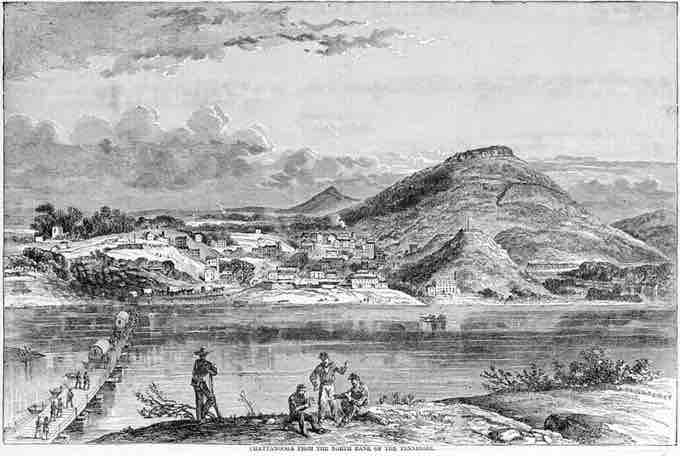The Chattanooga Campaign was a series of maneuvers and battles in October and November 1863, during the American Civil War. Chattanooga was a vital rail hub and an important manufacturing center for the production of iron and coke, located on the navigable Tennessee River. In September 1863, the Union Army of the Cumberland, under Major General William S. Rosecrans, executed a series of maneuvers that forced Confederate General Braxton Bragg and his Army of Tennessee to abandon Chattanooga and withdraw into northern Georgia. Rosecrans pursued Bragg, and the two armies collided at the Battle of Chickamauga on September 19–20, with the Confederates coming out victorious.
Grant and Bragg
Portraits of Maj. Gen. Ulysses S. Grant (left) and Gen. Braxton Bragg (right), commanding generals of the Chattanooga Campaign
Bragg had three alternative courses of action: He could outflank Rosecrans by crossing the Tennessee either below or above the city, assault the Union force directly in their fortifications, or starve the federals by establishing a siege line. The flanking option was deemed to be impracticable because Bragg's army was short on ammunition, they had no pontoon for river crossing, and Longstreet's corps from Virginia had arrived at Chickamauga without wagons. A direct assault was too costly against a well-fortified enemy. Receiving intelligence that Rosecrans's men had only six days of rations, Bragg chose the siege option, while attempting to accumulate sufficient logistical capability to cross the Tennessee.
Bragg's army besieged the city, threatening to starve the Union forces into surrender. The Confederates established themselves on Missionary Ridge and Lookout Mountain, both of which had excellent views of the city, the Tennessee River, and the Union's supply lines. In Chattanooga, Rosecrans was stunned by the defeat of his army and became psychologically unable to take decisive action to lift the siege. President Abraham Lincoln remarked that Rosecrans seemed, "confused and stunned like a duck hit on the head." Union soldiers began to feel the effect of extremely short rations, and many of their horses and mules died. The only supply line that was not controlled by the Confederates was a roundabout, tortuous course nearly 60 miles long. Heavy rains began to fall in late September, washing away long stretches of the mountain roads.
The Union high command began immediate preparations to relieve the city, and Major General Ulysses S. Grant was given command of Union forces in the West. Significant reinforcements began to arrive with him in Chattanooga from Mississippi and the eastern theater. The chief engineer of the Army of the Cumberland had devised a more reliable supply line to the troops in Chattanooga. He briefed Grant immediately after the new commander's arrival, and Grant enthusiastically endorsed the plan. Brown's Ferry crossed the Tennessee River with a navigable point that could be reached by Union supply boats. If the Army of the Cumberland could seize Brown's Ferry and link up with other forces, a reliable, efficient supply line—soon to become known as the "Cracker Line"—would be open. A force at Brown's Ferry would also threaten the right flank of any Confederate movement into the valley. After opening the "Cracker Line" to feed his starving men and animals, Grant's army fought off a Confederate counterattack at the Battle of Wauhatchie on October 28–29, 1863. Further battles took place at Orchard Knob, Lookout Mountain, Missionary Ridge, and Rossville Gap, resulting in Confederate retreat and their pursuit by Union soldiers, which the Confederates effectively thwarted.
On November 25, General William T. Sherman's attack on Bragg's right flank made little progress. Hoping to distract Bragg's attention, Grant authorized Thomas's army to advance in the center of his line to the base of Missionary Ridge. A combination of misunderstood orders and the pressure of the tactical situation caused Thomas's men to surge to the top of Missionary Ridge, routing the Army of Tennessee, which retreated while successfully fighting off the Union pursuit. Bragg's defeat eliminated the last Confederate stronghold in Tennessee and opened the door to an invasion of the Deep South, leading to Sherman's Atlanta Campaign of 1864. Casualties for the Union Army amounted to 5,824 of about 56,000 engaged; Bragg reported Confederate casualties of 6,667 out of about 44,000. The loss caused division within Confederate Army leadership. Confederate enthusiasm had risen so high after Chickamauga, but had been dashed at Chattanooga. The Union now held undisputed control of the state of Tennessee, including Chattanooga, the "Gateway to the Lower South." The city became the supply and logistics base for Sherman's 1864 Atlanta Campaign and the Army of the Cumberland. Grant won his final battle in the West prior to receiving command of all Union armies in March 1864.

"Chattanooga from the North Bank of the Tennessee."
Chattanooga viewed from the north bank of the Tennessee River, 1863. The Union Army pontoon bridge is shown on the left, Lookout Mountain at the right rear, and Chattanooga in the background. The small hill in front of Lookout Mountain is Cameron Hill, which was significantly flattened during twentieth-century development of the city.